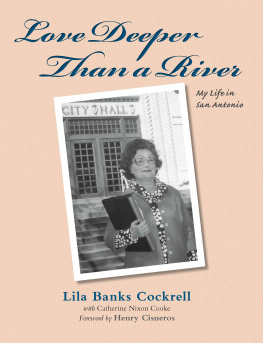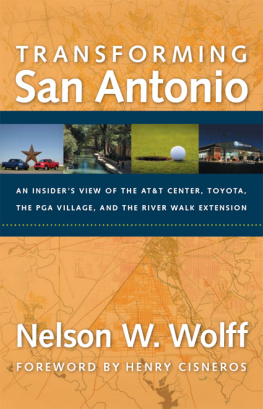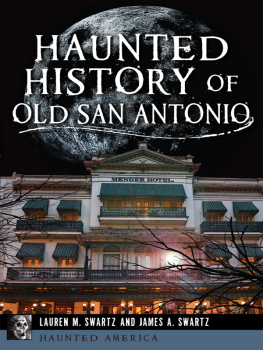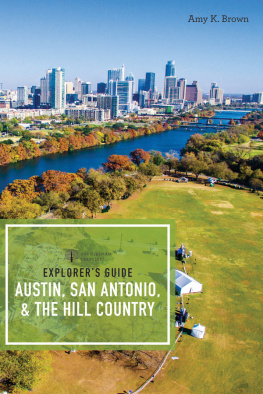
LOVE DEEPER THAN A RIVER
Love Deeper Than a River
My Life in San Antonio
LILA BANKS COCKRELL
with Catherine Nixon Cooke
Foreword by Henry Cisneros
Published by Maverick Books,
an imprint of Trinity University Press
San Antonio, Texas 78212
Copyright 2019 by Lila Banks Cockrell
All rights reserved. No part of this book may be reproduced in any form or by any electronic or mechanical means, including information storage and retrieval systems, without permission in writing from the publisher.
Book design by BookMatters, Berkeley
All images appear courtesy of the author
Back cover: Photograph L-7325-047-02, San Antonio Light Photograph Collection, UTSA Special Collections, Institute of Texan Cultures
ISBN 978-1-59534-887-6 hardcover
ISBN 978-1-59534-888-3 ebook
Trinity University Press strives to produce its books using methods and materials in an environmentally sensitive manner. We favor working with manufacturers that practice sustainable management of all natural resources, produce paper using recycled stock, and manage forests with the best possible practices for people, biodiversity, and sustainability. The press is a member of the Green Press Initiative, a nonprofit program dedicated to supporting publishers in their efforts to reduce their impacts on endangered forests, climate change, and forest-dependent communities.
The paper used in this publication meets the minimum requirements of the American National Standard for Information SciencesPermanence of Paper for Printed Library Materials, ANSI 39.481992.
Printed in Canada
CIP data on file at the Library of Congress
23 22 21 20 19| 5 4 3 2 1
In memory of my beloved husband,
Sidney Earl Cockrell Jr.,
and in honor of our children
CONTENTS
FOREWORD
Henry Cisneros
In his 1998 book, Tom Brokaw bestowed the sobriquet the Greatest Generation on the cohort of Americans who came of age in the years of the Great Depression and World War II. These Americans lived through the crushing economic downturn whose arrival was marked by the frightening stock market crash of 1929, and they demonstrated the grit to fight through the tumult, contraction, uncertainty, and personal sacrifices that characterized the 1930s. The world economy was battered, and the instability it caused soon degenerated into global political and security chaos. When the United States was pulled into the global conflagration by Japans attack on Pearl Harbor and Germanys blitzkrieg across Europe and Africa, that same generation of Americans put on military uniforms, mastered the requirements of warfare, and fought the Axis powers to the death.
The early 1940s were years of severe hardship at home and painful sacrifices on battlefields abroad. They were years that required courage and commitment to patriotic action. And they evoked in the Greatest Generation not only attributes of character and selflessness, but also, in the aftermath of the war, the confidence and optimism to will the United States into its essential role as the leader of the community of nations in the quest for world peace, economic prosperity, scientific advances, medical breakthroughs, and social progress. Their legacy of postwar engagement includes the United Nations, the Marshall Plan, the security umbrella of the Pax Americana, modern consumer products and services, the interstate highway system, the effective eradication of diseases such as polio and tuberculosis, the space program, and the civil rights laws. These advances and many others are the results of a collective generational effort, but they are also the products of individual commitments and beliefs.
As long as I have known Lila Cockrell, I have thought of her as a quintessential member of the Greatest Generation. Everything about her affirms her love of country and of Americas core values, a sense of duty, and the resolute responsibility of the Greatest Generation. Lila knows America well. Her family roots, her experiences as a child, and her formative years in Fort Worth, New York, San Antonio, and Dallas taught her about different places, people, and public roles. Lila showed from early life the natural intelligence, lively curiosity, and well-placed confidence that would serve her in good stead throughout her life. Family life for Lila in the 1920s and 1930s was a Norman Rockwell tableau of earnestness, manners, studiousness, and growing awareness. She saw in her uncles and stepfather respect for the principles of the law and for the efficacy of public service. She excelled at Southern Methodist University and was prepared to follow in her familys footsteps of meaningful societal contributions. She realized her own substantial capabilities and began the lifelong process of diplomatically but firmly applying her prodigious capacities in an America where leadership posts were still largely reserved for men.
Lila tells the story of how she met the love of her life, Sid Cockrell, at a YWCA conference in Colorado. She recounts that after seeing him in the post office at Estes Park, she told her roommate that she had just met the man she was going to marry. It was a natural connection of two smart, service-oriented, and attractive young people. Sid had an amiable, easygoing, wholesome, all-American persona. I thought years later when I met him that he would have made a perfectly good stand-in for Jimmy Stewart in a movie role. He was definitely a major reason why Lila would be Lila in the years to come. They had an old-fashioned romance that never ended and was obvious in the mutual admiration and support they gave each other, not to mention the appreciative smiles and sweet nothings they exchanged into their seventies. After that initial meeting they courted from a distance and married in 1942, with the war in Europe and the Pacific well under way. Since Sid was already on active duty, they started married life on the post of Fort Sill, in Oklahoma.
As with many Greatest Generation couples, history intervened and personal plans were interrupted. Each of the newlyweds had officer commissions in the U.S. military, Sid as an army officer and Lila as a navy WAVES officer. Sid served as a member of a generals staff, including a tour of duty in Iceland, and Lila served in administrative positions in Washington. Both of their lives thereafter were influenced by their leadership responsibilities and by their service to the nation in that time of war.
Like other members of the Greatest Generation, Sid and Lila committed enthusiastically to peacetime pursuits as the war ended. It was a full life: Sids career in organizational management in Dallas and San Antonio; the birth of two daughters, Carol and Cathy; household duties, volunteer work, and civic leadership for Lila. In 1963 Lila became the first woman to serve on the San Antonio city council in a city government headed by a strong leader, Mayor Walter McAllister. It was an important time for the city, dominated by the planning and execution of HemisFair 1968. Lila observed and learned the requirements of leadership in a growing city and came to understand the rhythms and complexities of a diverse, multicultured, and historic community.
When she was urged to stand for election as mayor in 1975 and decided to enter the race, it was as if Lila had been preparing her entire life to lead a city that needed her steady and calming leadership. Every strand of confidence, knowledge, experience, and instinct from a lifetime of learning and service, of love and faith, was applied to the task at hand. She was the first woman to be elected mayor of San Antonio and the first woman mayor of a major American city. She was the first mayor directly chosen by the San Antonio electorateas opposed to being voted in by city council members. And she was exactly what the city needed to bring civility and decorum to an era of implacable divisions, bare-knuckled politics, and swirling resentments.
Next page










